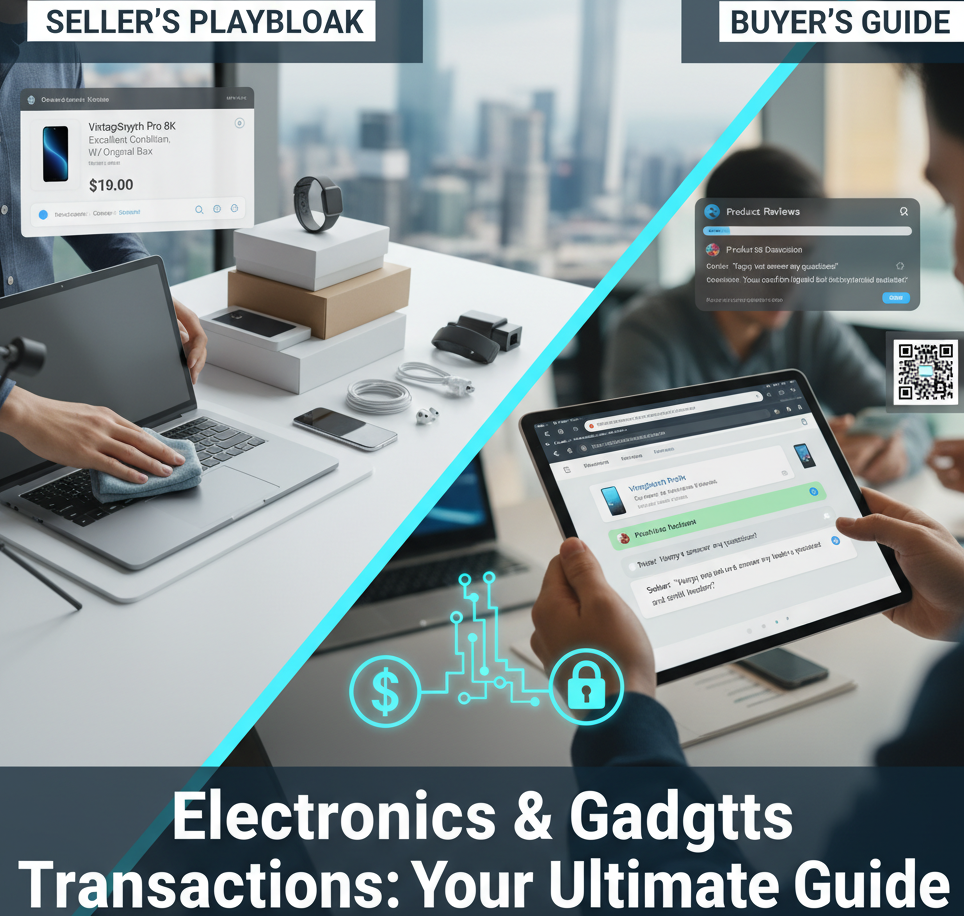In today’s fast-paced digital age, electronics and gadgets are no longer luxury items but essential tools that power our daily lives. From smartphones and laptops to smart home devices and wearables, the market is constantly evolving, presenting a dynamic landscape for both buyers and sellers. Whether you’re looking to upgrade your old device, sell a pre-loved gadget, or start a small e-commerce business, understanding the intricacies of electronics and gadget transactions is crucial for a smooth and successful experience. This comprehensive guide will walk you through the key aspects of buying and selling, providing valuable tips to help you navigate this bustling market with confidence.
The Booming Market of Electronics and Gadgets
The global electronics market is a behemoth, driven by rapid technological advancements and increasing consumer demand. . The convenience of online marketplaces, coupled with the sheer variety of products available, has made it easier than ever to buy and sell. However, this accessibility also comes with challenges, including intense competition, the risk of scams, and the need to stay informed about market trends.
For sellers, the opportunity is immense. The resale market for electronics is particularly strong, as consumers are increasingly seeking affordable, refurbished, or second-hand devices. For buyers, the choices are endless, ranging from brand-new, cutting-edge technology to budget-friendly options that still offer excellent performance.
A Seller’s Playbook: Maximizing Your Profits
Selling electronics and gadgets requires a strategic approach. It’s not just about listing an item; it’s about presenting it in the best possible light and reaching the right audience.
1. Preparation is Key
Before you even think about listing your gadget, thoroughly prepare the item for sale. This means cleaning it meticulously, backing up and wiping all personal data, and performing a factory reset. A clean, data-free device not only looks more appealing but also reassures the buyer that their privacy is protected. If you have the original packaging, cables, and accessories, include them. This significantly increases the item’s value and makes your listing more professional.
2. Crafting the Perfect Listing
Your listing is your storefront. It needs to be detailed, accurate, and visually appealing.
- High-Quality Photos: Take clear, well-lit photos from multiple angles. Showcase the item’s condition, highlighting any minor scratches or imperfections to build trust.
- Detailed Description: Write a comprehensive description that includes the brand, model number, specifications (e.g., RAM, storage capacity), and a brief history of the device (how long you’ve had it, how it was used). Be honest about the device’s condition, including any defects or repairs.
- Competitive Pricing: Research similar listings on various platforms (e.g., eBay, Facebook Marketplace, specialized tech forums) to determine a fair and competitive price. Consider the device’s age, condition, and current market demand. A price that is too high will deter buyers, while a price that is too low may make them question the device’s authenticity.
3. Choosing the Right Platform
The platform you choose can make or break your sale. Each one has its pros and cons.
- eBay: A global marketplace with a massive user base. It offers seller protection and various shipping options but can have higher fees.
- Facebook Marketplace: Great for local sales, which allows for in-person transactions and avoids shipping costs. It has zero listing fees, but transactions are less protected.
- Specialized Tech Forums and Websites: Platforms like Swappa or Gazelle are dedicated to tech and electronics, attracting serious buyers. They often have stricter quality controls, which can be a good thing for both parties.
A Buyer’s Guide: Making a Smart Purchase
Buying electronics, especially used ones, requires caution and due diligence. A smart buyer knows how to spot a good deal and avoid potential scams.
1. Do Your Homework
Before you commit to a purchase, research the product thoroughly. Read reviews, watch unboxing videos, and compare specifications. Understand the typical market value of the item you’re interested in. If a deal seems too good to be true, it probably is.
2. Scrutinize the Listing
- Read the Description Carefully: Look for keywords like “new,” “refurbished,” “used,” or “for parts only.” A good seller will be transparent about the device’s condition. If the description is vague or lacks details, ask the seller for more information.
- Examine the Photos: Check for consistent lighting and multiple angles. If the photos are blurry, generic, or look like they were pulled from a manufacturer’s website, be wary.
3. The Art of Communication
Don’t hesitate to communicate with the seller. Ask questions about the device’s history, battery life, and any known issues. A responsive and transparent seller is a good sign. If they are evasive or unwilling to answer your questions, it might be best to walk away.
4. Secure Your Transaction
- Payment Methods: Use secure payment methods that offer buyer protection, such as PayPal Goods and Services. Avoid direct bank transfers or peer-to-peer payment apps for large transactions with unknown sellers.
- In-Person Transactions: If you’re meeting a local seller, choose a safe, public location. Test the device before handing over the money. Check the serial number to ensure it matches the one in the listing and that the device hasn’t been reported stolen.
The Future of Electronics Transactions
The future of buying and selling electronics and gadgets is likely to be shaped by new technologies like blockchain for provenance tracking and AI-driven pricing algorithms. These innovations will aim to create more transparent, secure, and efficient marketplaces. The rise of sustainable consumption is also pushing the market towards more circular models, where refurbishing and recycling old devices become the norm.
Whether you’re a seasoned seller or a first-time buyer, understanding these principles will empower you to make informed decisions and navigate the electronics market successfully. By focusing on preparation, transparency, and security, you can turn a potentially complicated process into a rewarding experience. The world of gadgets and electronics is more accessible than ever, and with the right knowledge, you can thrive in it.







